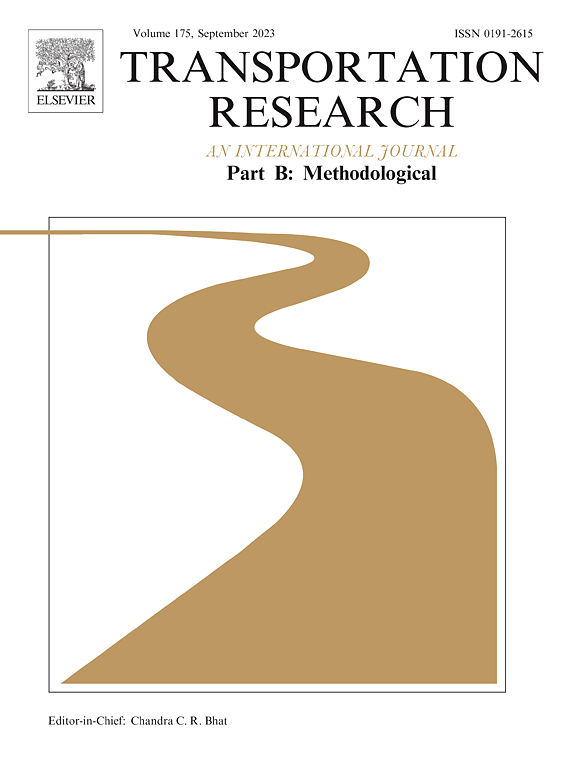C-MP:使用最大压力框架的分散自适应协调交通信号控制
IF 6.3
1区 工程技术
Q1 ECONOMICS
引用次数: 0
摘要
协调的交通信号寻求通过一系列紧密间隔的十字路口提供不间断的车辆流量,通常使用预定义的固定信号时间和偏移量。然而,当使用基于观察到的交通状况动态改变信号时间的自适应交通信号时,协调通常是不可能的,特别是在分散的系统中,这些决策是在每个十字路口独立做出的。为了缓解这一问题,本文引入了一种新的基于最大压力的交通信号框架,该框架专门寻求在分散决策下提供协调。提出的协调最大压力(C-MP)算法使用车辆的空间平均速度(从探测器或联网车辆(CV)环境中获得)来明确检测自由流动的车辆排,并优先考虑它们沿着走廊的移动。具体来说,上游排被检测到,并增加其在MP框架中的权重以提供优先权,而下游排被检测到,并减少其权重以确保走廊间的交通畅通。该研究分析证明了C-MP保持了理想的最大稳定性,而在动脉网络上进行的微观模拟分析表明,与基准MP控制策略相比,C-MP能够实现更大的稳定区域。仿真结果还表明,该控制算法可以有效地协调沿主干道方向的交通信号,而无需明确指定偏移量或约束。结果还表明,C-MP通过平衡对次要方向车辆的负面影响,在减少通道级和网络级的旅行时间和燃料消耗方面优于基准协调策略。当车辆子集为控制器提供输入时,所提出的算法也能有效地工作,就像部分CV环境中的情况一样。本文章由计算机程序翻译,如有差异,请以英文原文为准。
C-MP: A decentralized adaptive-coordinated traffic signal control using the Max Pressure framework
Coordinated traffic signals seek to provide uninterrupted vehicular flow through a series of closely spaced intersections, typically using pre-defined fixed signal timings and offsets. However, coordination is typically not possible when using adaptive traffic signals that dynamically change signal timings based on observed traffic conditions, particularly in decentralized systems where these decisions are made independently at each intersection. To alleviate this issue, this paper introduces a novel Max Pressure-based traffic signal framework that specifically seeks to provide coordination even under decentralized decision-making. The proposed Coordinated Max Pressure (C-MP) algorithm uses the space mean speeds of vehicles – obtained from detectors or in a connected vehicle (CV) environment – to explicitly detect freely flowing platoons of vehicles and prioritizes their movement along a corridor. Specifically, upstream platoons are detected, and their weight in the MP framework is increased to provide priority, while downstream platoons are detected, and their weight is reduced to ensure smooth traffic flow across corridors. The study analytically proves that C-MP maintains the desirable maximum stability property, while micro-simulation analyses conducted on an arterial network demonstrate its ability to achieve a larger stable region compared to benchmark MP control policies. Simulation results also reveal that the proposed control algorithm can effectively coordinate traffic signals in both directions along an arterial without explicitly assigned offsets or constraints. The results also reveal C-MP's superiority to benchmark coordination strategies in reducing travel time, and fuel consumption both at the corridor level and the network level by balancing the negative impact imparted to vehicles in the minor direction. The proposed algorithm also functions effectively when a subset of vehicles provide input to the controller, as would be the case in a partial CV environment.
求助全文
通过发布文献求助,成功后即可免费获取论文全文。
去求助
来源期刊
CiteScore
12.40
自引率
8.80%
发文量
143
审稿时长
14.1 weeks
期刊介绍:
Transportation Research: Part B publishes papers on all methodological aspects of the subject, particularly those that require mathematical analysis. The general theme of the journal is the development and solution of problems that are adequately motivated to deal with important aspects of the design and/or analysis of transportation systems. Areas covered include: traffic flow; design and analysis of transportation networks; control and scheduling; optimization; queuing theory; logistics; supply chains; development and application of statistical, econometric and mathematical models to address transportation problems; cost models; pricing and/or investment; traveler or shipper behavior; cost-benefit methodologies.

 求助内容:
求助内容: 应助结果提醒方式:
应助结果提醒方式:


